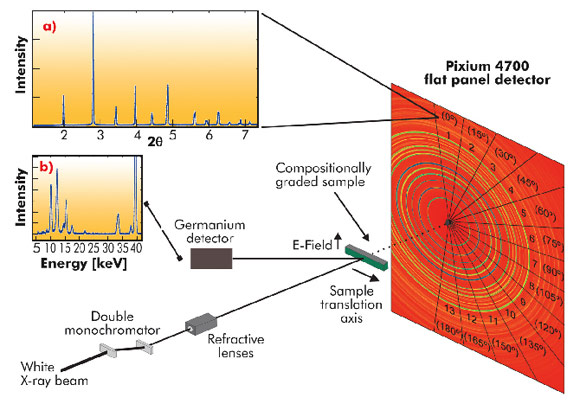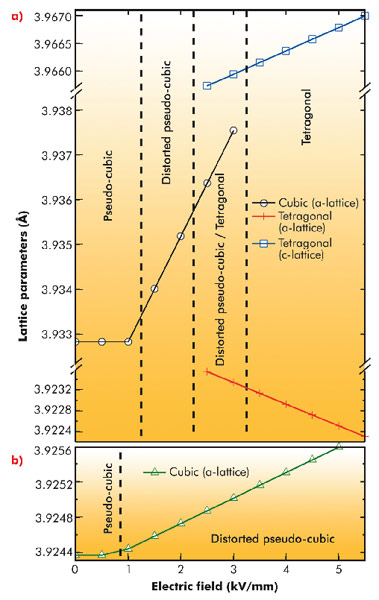- Home
- Users & Science
- Scientific Documentation
- ESRF Highlights
- ESRF Highlights 2010
- Structure of materials
- Electric-field-induced phase-change behaviour in (Bi0.5Na0.5)TiO3–BaTiO3–(K0.5Na0.5)NbO3: A combinatorial investigation
Electric-field-induced phase-change behaviour in (Bi0.5Na0.5)TiO3–BaTiO3–(K0.5Na0.5)NbO3: A combinatorial investigation
Electro-mechanical coupling in materials is a property that is widely exploited in many technological applications such as ultrasonic imaging, nanopositioning, and fuel injection systems. There has been much progress in recent years towards the development of lead-free piezoelectric ceramics in the hope of replacing widely used lead zirconate titanate (PZT) materials. From extensive work on PZT, it is known that good piezoelectric properties are obtained in samples with compositions near phase boundaries. A detailed investigation of possible candidate materials for useful piezoelectric ceramics shows that only a small number of elements are feasible as building blocks for new, competitive ceramics based on the perovskite structure. Preparation through traditional synthesis routes of the many concentrations in which these elements can be combined would be a difficult and painstaking process. Here we show that it is possible to create a compositional gradient by allowing diffusion between independent end member compositions during the ceramic sintering process. Independent compositions can then be probed within this gradient using a high energy X-ray micro-beam.
High-energy X-ray scattering experiments were carried out at beamlines ID15A and ID15B. A schematic of the experimental setup for ID15A is shown in Figure 46, where a beam energy of 75.3 keV was selected by a double bent Laue monochromator. Refractive lenses were used to focus the beam to approximately 45 x 45 µm2 at the sample. The sample was placed inside an electric field chamber that was translatable in the direction parallel to the compositional gradient. X-ray diffraction images were collected in transmission using a large area detector. With this setup it was possible to measure the sample composition using quantitative X-ray fluorescence and simultaneously obtain the structure of the materials as a function of the applied electric-field strength.
 |
|
Fig. 46: Schematic diagram of the experimental setup at ID15A. |
It was shown that samples in the range from 0.93(Bi0.5Na0.5)TiO3–0.07BaTiO3 to 0.86(Bi0.5Na0.5)TiO3–0.14(K0.5Na0.5)NbO3 underwent quite different mechanisms of electric-field-induced strains (Figure 47). Macroscopic property measurements are unable to distinguish between competing mechanisms at the atomic and microstructural scales. Here, however, we demonstrated that within this compositional range a variety of electrostrictive, phase transformation, domain switching, and piezoelectric strain mechanisms were active. Depending on the final application, such mechanisms either have a positive or negative effect on the quality of the product, thus rapid characterisation such as this is an invaluable tool in the identification of useful materials.
Approximately ten independent compositions could be sampled within the combinatorial specimen. However, most of these compositions are close to the end-member concentrations owing to the limited diffusion of atomic species at the boundary during sintering. Further development of sample preparation methods to increase these diffusion lengths is needed. An ideal experiment would involve a graded boundary width of 2 mm and a beam size of 20 µm (readily available at synchrotron X-ray sources). If such an experiment could be realised then it may enable up to 100 compositions to be sampled, increasing the productivity of sample preparation significantly when exploring large phase diagrams. A set of binary combinatorial samples, as studied here, could be selected in order to map the entire BNT-BT-KNN ternary phase diagram with greatly increased speed over regular sample preparation and analysis techniques.
Principal publication and authors
J.E. Daniels (a,b), W. Jo (c), V. Honkimäki (a), J. Rödel (c) and J.L. Jones (d), Acta Materialia 58, 2103-2111 (2010).
(a) ESRF
(b) School of Materials Science and Engineering, University of New South Wales, Sydney (Australia)
(c) Institute of Materials Science, Technische Universität Darmstadt (Germany)
(d) Department of Materials Science and Engineering, University of Florida, Gainesville (USA)




